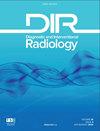MRI in the differential diagnosis of primary architectural distortion detected by mammography.
IF 2.1
4区 医学
Q2 Medicine
引用次数: 21
Abstract
PURPOSE We aimed to evaluate the diagnostic accuracy of a combination of dynamic contrast-enhanced magnetic resonance imaging (DCE-MRI) and apparent diffusion coefficient (ADC) values in lesions that manifest with architectural distortion (AD) on mammography. METHODS All full-field digital mammography (FFDM) images obtained between August 2010 and January 2013 were reviewed retrospectively, and 57 lesions showing AD were included in the study. Two independent radiologists reviewed all mammograms and MRI data and recorded lesion characteristics according to the BI-RADS lexicon. The gold standard was histopathologic results from biopsies or surgical excisions and results of the two-year follow-up. Receiver operating characteristic curve analysis was carried out to define the most effective threshold ADC value to differentiate malignant from benign breast lesions. We investigated the sensitivity and specificity of FFDM, DCE-MRI, FFDM+DCE-MRI, and DCE-MRI+ADC. RESULTS Of the 57 lesions analyzed, 28 were malignant and 29 were benign. The most effective threshold for the normalized ADC (nADC) was 0.61 with 93.1% sensitivity and 75.0% specificity. The sensitivity and specificity of DCE-MRI combined with nADC was 92.9% and 79.3%, respectively. DCE-MRI combined with nADC showed the highest specificity and equal sensitivity compared with other modalities, independent of the presentation of calcification. CONCLUSION DCE-MRI combined with nADC values was more reliable than mammography in differentiating the nature of disease manifesting as primary AD on mammography.MRI在乳房x光检查原发性建筑畸变的鉴别诊断中的价值。
目的:探讨动态对比增强磁共振成像(DCE-MRI)和表观扩散系数(ADC)对乳房x线摄影表现为结构畸变(AD)病变的诊断准确性。方法回顾性分析2010年8月至2013年1月期间获得的所有全视野数字乳房x线摄影(FFDM)图像,并纳入57例AD病变。两名独立的放射科医生审查了所有乳房x光片和MRI数据,并根据BI-RADS词典记录病变特征。金标准是活检或手术切除的组织病理学结果以及两年随访的结果。进行受试者工作特征曲线分析,确定区分乳腺良恶性病变最有效的阈值ADC值。我们研究了FFDM、DCE-MRI、FFDM+DCE-MRI和DCE-MRI+ADC的敏感性和特异性。结果57个病变中,28个为恶性,29个为良性。归一化ADC (nADC)的最有效阈值为0.61,敏感性为93.1%,特异性为75.0%。DCE-MRI联合nADC的敏感性和特异性分别为92.9%和79.3%。与其他方式相比,DCE-MRI联合nADC具有最高的特异性和相同的敏感性,与钙化的表现无关。结论dce - mri联合nADC值在鉴别乳腺x线摄影上表现为原发性AD的疾病性质方面比乳腺x线摄影更可靠。
本文章由计算机程序翻译,如有差异,请以英文原文为准。
求助全文
约1分钟内获得全文
求助全文
来源期刊
CiteScore
3.50
自引率
4.80%
发文量
69
审稿时长
6-12 weeks
期刊介绍:
Diagnostic and Interventional Radiology (Diagn Interv Radiol) is the open access, online-only official publication of Turkish Society of Radiology. It is published bimonthly and the journal’s publication language is English.
The journal is a medium for original articles, reviews, pictorial essays, technical notes related to all fields of diagnostic and interventional radiology.

 求助内容:
求助内容: 应助结果提醒方式:
应助结果提醒方式:


